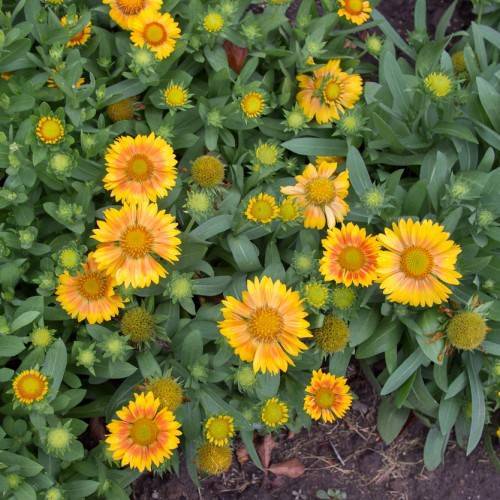
blanket flower
Gaillardia 'Arizona Apricot'
Cycle:
Herbaceous Perennial
Watering:
Minimum
Hardiness Zone:
4 - 10
Flowers:
Flowers
Sun:
Full sun
Leaf:
Yes
Growth Rate:
Low
Maintenance:
Low
Salt Tolerant:
Yes
watering
The blanket flower (Gaillardia 'Arizona Apricot') does best when kept on the dry side. Water deeply, but infrequently. Aim for thorough soaking of the soil every 7-14 days, depending on the season and the weather in your area. In summer months when the days are longer and the weather is hot, increase to weekly watering. During the winter, cut back to every other week. When in doubt, wait another day or 2. Overwatering is more of an issue than underwatering. Keep an eye out for signs of drooping or wilting, and adjust your watering schedule accordingly.
sunlight
Blanket Flower (Gaillardia 'Arizona Apricot') requires full sunlight for optimal growth and flowering. During the summer months they should receive at least 8 hours of direct sunlight per day, and in cooler months, at least 6 hours per day. Planting blanket flower in an area that receives at least 6 hours of daily sunlight will ensure the most abundant blooms.
pruning
The blanket flower (Gaillardia 'Arizona Apricot') is a hardy perennial that is easy to care for and does not need frequent pruning. It should be pruned only to remove any dead, diseased, or damaged growth, which can be done throughout the growing season. Pruning should also be done after the blooming period to encourage new, healthy growth and additional flowering. To do this, cut back the old flowering stems by a few inches or up to a quarter of its length, taking care not to damage the buds of new growth at the branch tips. This will help to ensure abundant blooms the following season.
Season
Hardiness Map
FAQ
Should blanket flowers be deadheaded?
Yes, blanket flowers should be deadheaded as this will encourage new growth and help create more blooms during their blooming season. Deadheading is the removal of any spent or wilted flowers, typically by gently pinching them off the stem with your fingers or by using clean and sharp pruners. This helps promote new growth and will keep the flowers looking tidy and healthy while also aiding in the blooming process.
Could blanket flowers be used as cut flowers?
Yes, blanket flowers (Gaillardia species) are an ideal choice for cut flowers. These flowers are bright and cheery, with unique and eye-catching blooms. Unlike many other wildflowers and garden plants, blanket flowers have long-lasting blooms that can easily last up to two weeks when cut. They are also very drought-tolerant, meaning they won’t quickly wilt when placed in water. Additionally, blanket flowers come in a variety of colors and shapes, and can be arranged in a variety of ways, making them very versatile in flower arranging and bouquet making.
Should blanket flowers be planted in groups or singly?
Blanket flowers, also known as gaillardia, look the best when planted in groups of three or more. Planting them in groups helps to create an eye-catching wave of blooms throughout your garden and an overall more natural look. On the other hand, if you want a more manicured look in your garden, you could plant blanket flowers singly. However, it's important to note that blanket flowers thrive best when planted in groups, as they are natively designed to grow in clusters.
Are blanket flowers invasive?
No, blanket flowers (Gaillardia spp.) are not considered invasive. These plants are actually native to North America and parts of Mexico and can often be found in areas such as meadows, roadsides, and open woodlands. Blanket flowers are also a popular garden plant due to their ease of care and tolerant nature to less than ideal soil conditions. They should not cause any damage to nearby ecosystems and can be a great addition to any garden.
Could blanket flowers be used in a wildflower meadow?
Yes, blanket flowers (Gaillardia pulchella) can be used in a wildflower meadow. These drought-tolerant flowers are quite hardy and full of bright colors such as red, orange and yellow, adding an extra splash of color. Blanket flowers tend to attract both butterflies and hummingbirds, adding to their appeal as a great way to add both beauty and pollinators to a wildflower meadow. Furthermore, they are typically low-maintenance and require little to no care. This makes them an excellent choice for novice gardeners who want to enjoy the wildflower meadow look without too much work.
Should blanket flowers be mulched?
Yes, blanket flowers should be mulched. Mulching blanket flowers helps to insulate the roots from extreme temperatures, retain moisture, and prevent weeds. It also adds organic matter which helps to maintain healthy soil structure. Blanket flowers should be mulched with an organic mulch such as bark chips, wood chips, dried leaves, or straw. The mulch should be about two to three inches deep and kept away from the base of the plant.
Are blanket flowers self-seeding?
Yes, blanket flowers are self-seeding. This means that when the flower’s petals drop off, the seed pods are left behind. These pod will then eventually dry up and when the conditions are right the seeds will sprout and the process of self-seeding will begin again. This means that blanket flowers can easily spread and naturalize if the conditions are right.
Do blanket flowers attract pollinators?
Yes, blanket flowers (Gaillardia pulchella) do attract pollinators such as bees, butterflies, and hummingbirds. The long-lasting, daisy-like flowers produce copious amounts of nectar that are a great attraction for these insects. Additionally, the bright colors of the flowers also help to draw in pollinators from far away. This species of flower is even known for attracting predatory wasps in to its flowers, which helps to keep insect pests under control as well.
